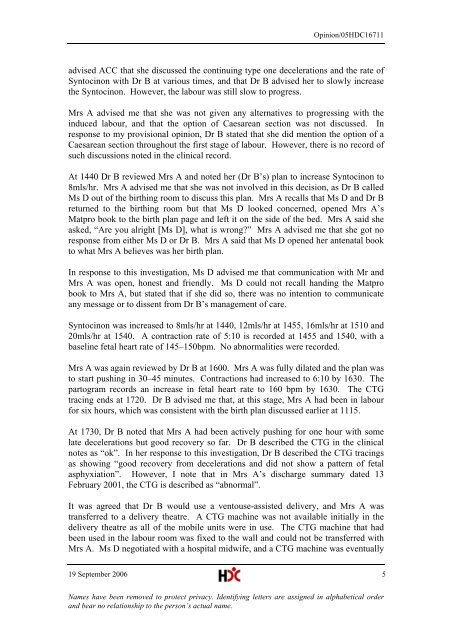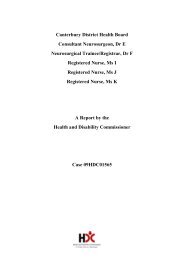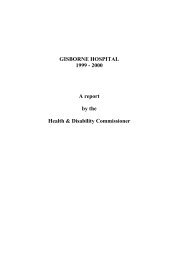Download the pdf version of this decision. - Health and Disability ...
Download the pdf version of this decision. - Health and Disability ...
Download the pdf version of this decision. - Health and Disability ...
Create successful ePaper yourself
Turn your PDF publications into a flip-book with our unique Google optimized e-Paper software.
Opinion/05HDC16711<br />
advised ACC that she discussed <strong>the</strong> continuing type one decelerations <strong>and</strong> <strong>the</strong> rate <strong>of</strong><br />
Syntocinon with Dr B at various times, <strong>and</strong> that Dr B advised her to slowly increase<br />
<strong>the</strong> Syntocinon. However, <strong>the</strong> labour was still slow to progress.<br />
Mrs A advised me that she was not given any alternatives to progressing with <strong>the</strong><br />
induced labour, <strong>and</strong> that <strong>the</strong> option <strong>of</strong> Caesarean section was not discussed. In<br />
response to my provisional opinion, Dr B stated that she did mention <strong>the</strong> option <strong>of</strong> a<br />
Caesarean section throughout <strong>the</strong> first stage <strong>of</strong> labour. However, <strong>the</strong>re is no record <strong>of</strong><br />
such discussions noted in <strong>the</strong> clinical record.<br />
At 1440 Dr B reviewed Mrs A <strong>and</strong> noted her (Dr B’s) plan to increase Syntocinon to<br />
8mls/hr. Mrs A advised me that she was not involved in <strong>this</strong> <strong>decision</strong>, as Dr B called<br />
Ms D out <strong>of</strong> <strong>the</strong> birthing room to discuss <strong>this</strong> plan. Mrs A recalls that Ms D <strong>and</strong> Dr B<br />
returned to <strong>the</strong> birthing room but that Ms D looked concerned, opened Mrs A’s<br />
Matpro book to <strong>the</strong> birth plan page <strong>and</strong> left it on <strong>the</strong> side <strong>of</strong> <strong>the</strong> bed. Mrs A said she<br />
asked, “Are you alright [Ms D], what is wrong?” Mrs A advised me that she got no<br />
response from ei<strong>the</strong>r Ms D or Dr B. Mrs A said that Ms D opened her antenatal book<br />
to what Mrs A believes was her birth plan.<br />
In response to <strong>this</strong> investigation, Ms D advised me that communication with Mr <strong>and</strong><br />
Mrs A was open, honest <strong>and</strong> friendly. Ms D could not recall h<strong>and</strong>ing <strong>the</strong> Matpro<br />
book to Mrs A, but stated that if she did so, <strong>the</strong>re was no intention to communicate<br />
any message or to dissent from Dr B’s management <strong>of</strong> care.<br />
Syntocinon was increased to 8mls/hr at 1440, 12mls/hr at 1455, 16mls/hr at 1510 <strong>and</strong><br />
20mls/hr at 1540. A contraction rate <strong>of</strong> 5:10 is recorded at 1455 <strong>and</strong> 1540, with a<br />
baseline fetal heart rate <strong>of</strong> 145–150bpm. No abnormalities were recorded.<br />
Mrs A was again reviewed by Dr B at 1600. Mrs A was fully dilated <strong>and</strong> <strong>the</strong> plan was<br />
to start pushing in 30–45 minutes. Contractions had increased to 6:10 by 1630. The<br />
partogram records an increase in fetal heart rate to 160 bpm by 1630. The CTG<br />
tracing ends at 1720. Dr B advised me that, at <strong>this</strong> stage, Mrs A had been in labour<br />
for six hours, which was consistent with <strong>the</strong> birth plan discussed earlier at 1115.<br />
At 1730, Dr B noted that Mrs A had been actively pushing for one hour with some<br />
late decelerations but good recovery so far. Dr B described <strong>the</strong> CTG in <strong>the</strong> clinical<br />
notes as “ok”. In her response to <strong>this</strong> investigation, Dr B described <strong>the</strong> CTG tracings<br />
as showing “good recovery from decelerations <strong>and</strong> did not show a pattern <strong>of</strong> fetal<br />
asphyxiation”. However, I note that in Mrs A’s discharge summary dated 13<br />
February 2001, <strong>the</strong> CTG is described as “abnormal”.<br />
It was agreed that Dr B would use a ventouse-assisted delivery, <strong>and</strong> Mrs A was<br />
transferred to a delivery <strong>the</strong>atre. A CTG machine was not available initially in <strong>the</strong><br />
delivery <strong>the</strong>atre as all <strong>of</strong> <strong>the</strong> mobile units were in use. The CTG machine that had<br />
been used in <strong>the</strong> labour room was fixed to <strong>the</strong> wall <strong>and</strong> could not be transferred with<br />
Mrs A. Ms D negotiated with a hospital midwife, <strong>and</strong> a CTG machine was eventually<br />
19 September 2006 5<br />
Names have been removed to protect privacy. Identifying letters are assigned in alphabetical order<br />
<strong>and</strong> bear no relationship to <strong>the</strong> person’s actual name.
















